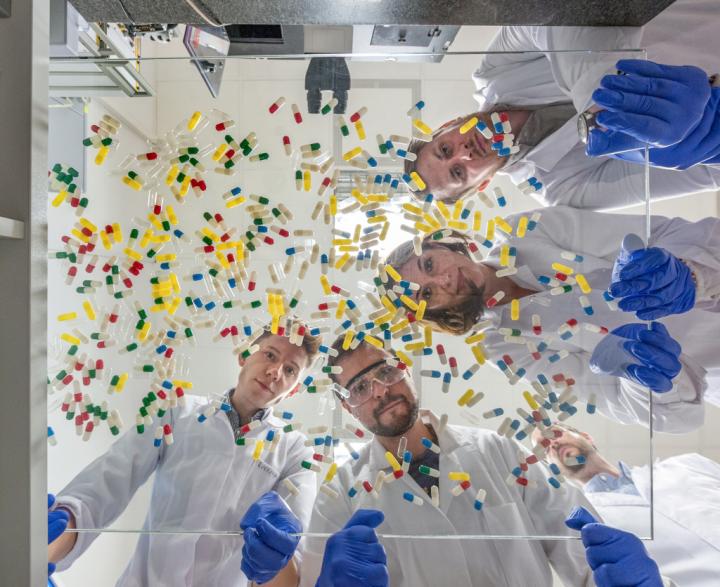
Credit: IPC PAS, Grzegorz Krzyzewski
Would you like to be able to find out which antibiotic combination works best for a particular patient? And do it in just 12 or maybe even 6 hours, in a point-of-care? Or maybe search for antibodies in thousands of samples at a time? It’s all possible with a new device invented by scientists from IPC PAS. It is cheap, fast & reliable, it can replace strip tests and give patients a better chance to fight disease.
A team led by prof. Piotr Garstecki is developing new tools for diagnostics. In a paper published in Micromachines the researchers wanted to show that combining different, simple methods can give users a simple bacterial susceptibility test kit. A kit that uses less reagents than a traditional susceptibility test in agar, less antibiotics, and is as easy to perform as an Etest. Users can also choose how to visualize the results, eg. use metabolism indicators of the bacteria, fluorescent dyes or see a colorimetric change.
“We wanted to test antimicrobial susceptibility as simply as possible, but not only for a single agent but also for combinations or under different conditions,” explains dr Ladislav Derzsi, one of the authors of the paper and supervisor of the project. “To deliver this new device, we matched several things that were discovered independently. For example we used standard UV and soft lithography techniques which are very common methods to fabricate microfluidic devices and we combined it with non-contact printing on machine which was designed especially for us.” By using this combination of methods scientists can very precisely position small droplets of any kind of liquid in microwells. In this case they were antibiotic solutions of different concentrations and in different combinations. They were printed inside microwells in a similar way that laser-jet or ink-jet printers do their job. “They have small nozzles and using piezoelectric forces they deliver very precise amounts of liquid: nanoliters to picoliters or even femtoliters,” says dr Derzsi. “We use similar technique only instead of ink we use antibiotics and we inject them not on paper but onto a soft elastomer. We let it slowly dry out under controlled conditions. The aqueous phase – water – evaporates and we’re left with just the very small amount of antibiotic.” The wells used for the experiment were quite large – 1 mm diameter – and their capacity was approx. 0.67 microliters. “In total we’re using 1024 wells in one chip. It is more than one order higher than classical plates with 96 wells despite being half the size. But it can be increased even to 10000 wells by decreasing their individual size,” says dr Derzsi.
To make it more user-friendly researchers bonded the device with a polymeric adhesive tape to seal it air-tight and then put it into vacuum. So the device is delivered to the end-user sterile and with inner negative pressure. “If we’d like to use it commercially, it could be additionally sealed in a vacuum bag [like we do with food items],” explains the scientist.
The user than has only to unpack it, inject first a bacterial solution, with a simple, commercially available pipette, and then add a small amount of oil which divides wells and helps avoid any cross-contamination between them. Then the whole pack has to be put into the incubator and one just has to wait to see, what is the optimal combination of antibiotics and their concentration; in other words – where do bacteria hesitate to grow or don’t grow at all.
A great advantage of the new testing system is its flexibility. One can produce sterile plates on demand, with different antibiotics in different combinations. “We used plates with 6 single antibiotics in 8 different concentrations and – to increase the precision – in 8 repetitions each. We also tested pair-wise combinations of these six antibiotics in several repetitions. It is possible to test combinations of an arbitrary number of different antibiotics, inhibitors and adjuvants in one well,” says dr Derzsi, “but usually doctors don’t use more than two at a time not to overburden patient’s organism. By using this new method doctors can test the patient and see which antibiotic or a combination work best for him, i.e. personalize the treatment and not rely on what works in a general population. Every person have a slightly different response to treatment, even with the very same sickness. It’s his bioflora, metabolic individuality and many other things. So one can say that new device is a step towards more personalized medicine. But it can be very helpful not only for a particular patient, but also for scientific purposes of finding new, non-obvious combinations of antibiotics that work better than known ones.
Although the work was done on bacteria and their antibiotic susceptibility, the method has the potential to be upgraded and after further testing used eg. for printing primers and do digital PCR to identify specific genes or antibodies. Especially that a single chip would cost no more than 5 euros.
Microfluidic methods have also an extra advantage: when searching for new drugs scientists often have a very limited amount of a potentially useful substance. Thanks to non-contact printing they can test more different concentrations and combinations of a potential cure without running out of the substrate too early.
###
This press release was prepared with funds from Foundation for Polish Science within the Team Tech program POIR.04.04.00-00-2159/16-00 (all authors) and NanoFun POIG.02.02.00-00-025/09.
The Institute of Physical Chemistry of the Polish Academy of Sciences (http://www.
of physical chemistry and chemical physics. Scientific research is conducted in nine scientific departments. CHEMIPAN R&D Laboratories, operating as part of the Institute, implement, produce and commercialize specialist chemicals to be used, in particular,
in agriculture and pharmaceutical industry. The Institute publishes approximately 200 original research papers annually.
Media Contact
Dr. Ladislav Derzsi
[email protected]
Related Journal Article
http://dx.




